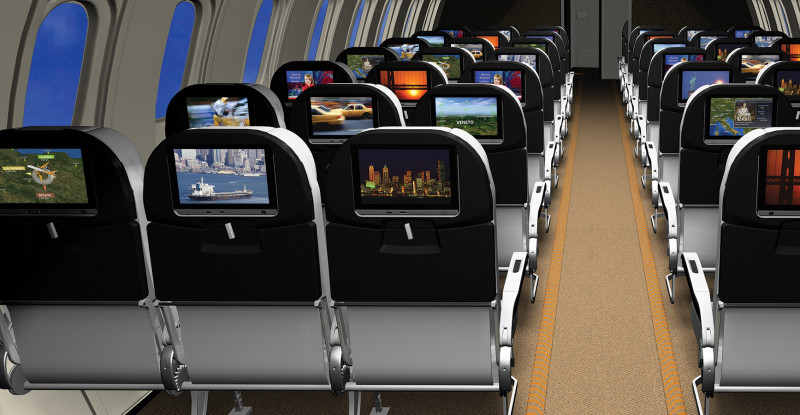Having mopped up the avionics business across Boeing’s next gen aircraft portfolio, including on the 787 and 777X, Rockwell Collins would seem primed to expand its footprint beyond the flight deck by offering inflight entertainment and connectivity in widebody cabins. But when it comes to IFEC, Rockwell says it is staying wholly focused on serving the single-aisle market with a more well-rounded portfolio.
“We’re making sure we have the technology in place to do exactly what we say we will do – to deliver a quality product and experience. We’ll keep our focus right now in the single-aisle market,” says Craig Elliott, Rockwell’s new vice president, airline cabin sales and marketing.
The company – which in 2012 was named the exclusive provider of flight deck displays for the 737 MAX – arrived this week at the Aircraft Interiors Expo in Hamburg with a more fully formed message about its IFEC portfolio for the 737 and other narrowbody types.
It has honed its messaging just in time, too. Elliott, a 20-year veteran at Rockwell, notes, “It’s been a long time since I’ve seen this type of excitement generated about this business we’re focused on.” A quick peek at Gogo’s share price today might give this impression as well.
In addition to offering its PAVES drop-down and in-seat entertainment system to the single-aisle market – the latter will be delivered linefit on a Sichuan Airlines Airbus A320 family aircraft in the October/November timeframe and on a Boeing 737 for an undisclosed carrier in January/February 2016 – Rockwell Collins is pitching a wireless IFE solution whose key strength is the ability to stream video content to over 250 passengers simultaneously.
Rockwell picked up the technology with its recent acquisition of Singapore and Indonesia-located Pacific Avionics, which competes with the likes of Kontron and Flight Focus on the server-and-WAPs front, but “provides us with a slightly different twist on the technology and allows us to jump down the development road and get us where we want to be quickly”, says Elliott, who believes the buy will give Rockwell a “competitive edge”. Rockwell had already done some work towards developing its own internal wireless IFE system, previously seeing Kontron as its preferred supplier, and tapping Global Eagle for wireless IFE software (formerly known as WISE; now known as Airworks WISE).
Elliott would not discuss if Airworks WISE will play as part of Rockwell’s new Pacific Avionics wireless IFE solution, other than to note, “We have an open architecture approach so we’re working with a lot of groups internally and externally to provide this comprehensive solution.”
The Pacific Avionics solution “will fit any aircraft” including widebodies, “but as we look at it, we see a near-term focus on single-aisle aircraft”, stresses Elliott. Likewise, as a value added reseller for Inmarsat’s forthcoming Global Xpress (GX) service – which Rockwell sees as having “some very strategic advantages” over Ku connectivity – Rockwell is selling to the single-aisle market.
As we’ve highlighted in the past, Rockwell has a checkered history in onboard entertainment. In 2006, after encountering years of challenges with its so-called TES in-seat entertainment product, the company famously opted not to develop IFE for the Airbus A380 and Boeing 787, which effectively pulled the manufacturer out of the twin-aisle market for IFE, and reduced competition for new aircraft models to a duopoly comprised of Panasonic Avionics and Thales.
We may never know if Rockwell management regrets the decision on some level. After all, it would now be in a position to offer nose-to-tail hardware on widebodies had it stayed the course. But the company is clearly now getting its house in order on single-aisle platforms.
“You’ve seen Rockwell for years, and we’ve been deliberate in keeping PAVES in the marketplace and now with the addition of Pacific Avionics and Global Xpress, all of a sudden the timing is right for Rockwell to make a statement in the IFEC business,” says Elliott, noting that all proficiencies will be combined “into the new Cabin Solutions group” whose comprehensive offering “steps beyond IFE and looks at what we can do from an application growth standpoint. We see an opportunity to bring the technology together that enables the next level of travel experience.”
In the cockpit, Rockwell’s Arinc unit – acquired in 2013 and now known as Information Management Services (IMS) – is a service provider for ACARS messaging and flight tracking, and competes with SITA.
A multinational company SITA has opted to create a new business organization with its Geneva-based subsidiary OnAir, and bring all products linked to e-aircraft – from ACARS and tracking to passenger connectivity – under one proverbial roof called SITA OnAir.
Noting that SITA OnAir’s approach to the market “is entirely up to them”, Elliott alludes to the potential difficulties the company might face, saying, “Having been around corporate America for a long time, partnerships are great, and working relationships are great, but organizational boundaries are real and it’s very tough to work across organizational boundaries, and that is one of the things we’re pleased about is IMS is part of the Rockwell Collins family; we’re not worried about different organizational structures. We’re part of the same family, and have the flexibility and latitude to do thing differently than other organizations.”
The two sides agree on at least one thing, however – some airlines carrying Inmarsat SwiftBroadband (SBB)-supported cabin connectivity now are poised to migrate to GX in the cabin and use the SBB channels for safety services in the cockpit. “It just makes sense,” says Elliott, and it is a new retrofit product.












